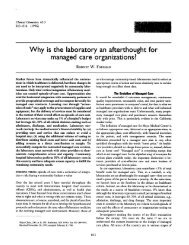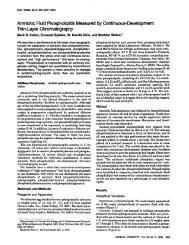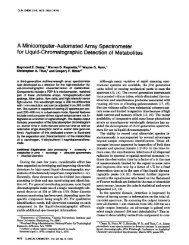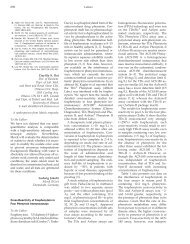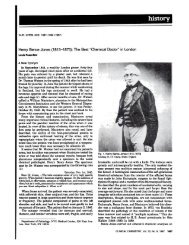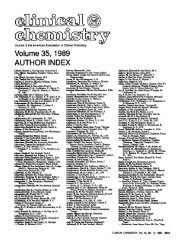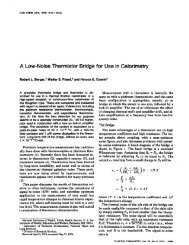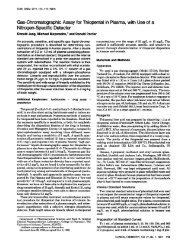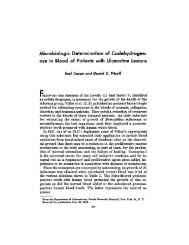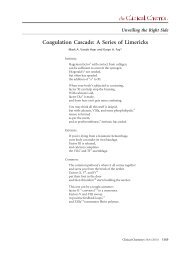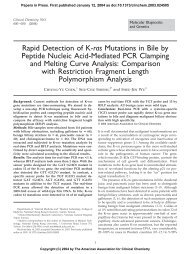Studies on the Determination of Bile Pigments - Clinical Chemistry
Studies on the Determination of Bile Pigments - Clinical Chemistry
Studies on the Determination of Bile Pigments - Clinical Chemistry
Create successful ePaper yourself
Turn your PDF publications into a flip-book with our unique Google optimized e-Paper software.
Vol. 10, No. 5, 1964 DETERMINATION OF UROBILINOGEN 445<br />
exposure <strong>of</strong> chromogeii extracts even to diffuse sunlight can produce<br />
pigments o<strong>the</strong>r than urobilin (“biliviolins”). Doubt has thus been<br />
cast up<strong>on</strong> <strong>the</strong> fundamental assumpti<strong>on</strong> <strong>of</strong> <strong>the</strong> test-viz., that urobilinogen<br />
which has underg<strong>on</strong>e oxidati<strong>on</strong> in <strong>the</strong> urine can again be reduced<br />
to urobiliriogen; indeed, this suspici<strong>on</strong> has been raised by Wats<strong>on</strong><br />
(7) and by Heilmeyer (8).<br />
The data in Table 1 suggest that it is <strong>the</strong> urine itself which interferes<br />
with <strong>the</strong> reducti<strong>on</strong> <strong>of</strong> urobilin. The good recovery <strong>of</strong> urobilinogen<br />
added to urine lends support to this hypo<strong>the</strong>sis. Spectrophotometric<br />
data presented also support this possibility; Fig. 2 shows that <strong>the</strong> reducti<strong>on</strong><br />
<strong>of</strong> urobilin in <strong>the</strong> presence <strong>of</strong> urine can produce ano<strong>the</strong>r substance<br />
different from urobilinogen (Curve C). In additi<strong>on</strong>, recovery<br />
experiments using direct Ehrlich’s aldehyde reacti<strong>on</strong> in urine suggest<br />
<strong>the</strong> c<strong>on</strong>cept <strong>of</strong> a negative interference: In <strong>the</strong>se experiments, <strong>the</strong> observati<strong>on</strong><br />
that <strong>the</strong> apparent urobilinogn level was somewhat increased<br />
when samples had stood for 24 hr. suggests that <strong>the</strong> interfering factor<br />
itself changes with time and that low recoveries from urine are due<br />
primarily to such interference ra<strong>the</strong>r than to an irreversible oxidati<strong>on</strong><br />
<strong>of</strong><br />
urobilinogen.<br />
To be sure, elevated levels <strong>of</strong> urobilinogen in disease states such as<br />
infectious hepatitis would not go undetected, despite <strong>the</strong> analytical<br />
problems ; however, in obstructive jaundice, where diminished amounts<br />
<strong>of</strong> urobilinogen are excreted because <strong>of</strong> <strong>the</strong> absence <strong>of</strong> intestinal re-<br />
Table 2. RECOVERY OF UROBILINOGEN FROM URINE BY DIRECT REACTION WITH EHRLICH’S<br />
REAGENT<br />
Sample preparati<strong>on</strong> (nil.) Am, tm. CHClii* --<br />
20 mg./<br />
100 ml.<br />
Sample Water Urine URGt<br />
Initial teat 24-hr. teat<br />
Urine 5 45 - 0.006 0.006<br />
*Readings represent “urobilinogen-aldebyde” extracted in 24 ml. chlor<strong>of</strong>orm from reducti<strong>on</strong><br />
<strong>of</strong> 7.5 ml. sample. Samples were preserved overnight at 30#{176} with 0.1 gm. Na,00a per 10 ml.<br />
sample and overlayed with 3 ml. mineral oil.<br />
tA 20-mg./100 ml. soluti<strong>on</strong> <strong>of</strong> urobilinogen was prepared by borohydride reducti<strong>on</strong> <strong>of</strong> urobilin.<br />
The soluti<strong>on</strong> was <strong>the</strong>n acidified with HCI to decompose <strong>the</strong> excess potassium horohydride.<br />
0.005 0.006<br />
Urohilinogen 45 - 5 0.500 0.380<br />
0.470 0.360<br />
Urine plus - 45 5 0.210 0.275<br />
urohilinogen 0.200 0.300




